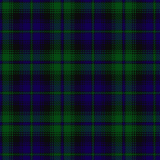Tartan of the 5th Royal Scots of Canada

When one thinks of Scotland, many iconic images come to mind; rolling green hills, ancient castles, and Nessie swimming in her loch. Even more memorable than these, however, is the patterned fabric which has come to symbolize Scottish culture itself: Tartan is the only textile design in the world of which a tiny scrap can evoke such feelings of pride, such identification with the historical struggles of Scots, and identification with those desirable traits associated with being Scottish - honesty, industriousness and bravery in battle.*
Although tartan-style fabrics have a very long history – a good portion of it not Scottish – today these textiles are most famous as badges of identification. Specific colors and their arrangements function as a symbolic language in their own right, representing individuals, families and clans, as well as professional groups, companies, and organizations. To the huge international family of Scots and their descendants - estimated at 40 to 60 million around the globe - tartan represents everything that is admirable and wholesome about the land of their fathers.*
Adopted as the official regimental tartan upon assuming a Scottish identity for the whole regiment in 1880. By 1883 the unit had become kilted but had enormous difficulty in getting a standard shade for the different shipments of tartan. The Regiment thus presented a very patchey appearance on parade and the decision was taken to go over to the Government 42nd pattern. Adoption of the Lorne tartan had been out of deference to the then-Marquis who was Governor-General of Canada. In due course the regiment became 'The Black watch (or Royal Highland Regiment) of Canada.'**
*http://www.tartansauthority.com/tartan/
**https://www.tartanregister.gov.uk/tartanDetails?ref=4
© Symbols.com
